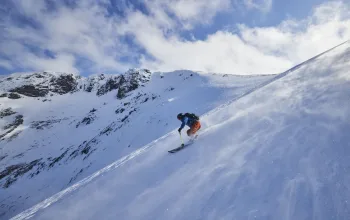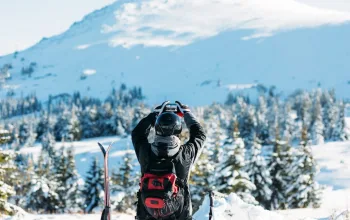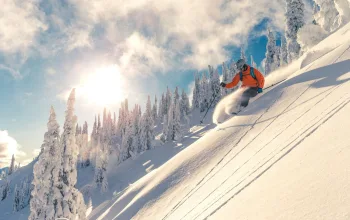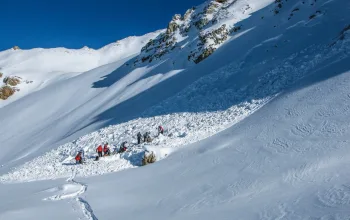This article is about how to regulate your speed in all conditions, from powder to ice to moguls and how to feel safer on the slopes - giving you the confidence to tackle more challenging terrain as you improve.
Firstly let’s clarify what we mean by ‘Speed Control’… Put simply, it means to be in control of the speed you are going. It doesn’t necessarily mean going slowly. Alex Bilodeau (Olympic gold – Moguls) and Ted Ligety (arguably re-writing the books in Giant Slalom) are great example of skiers who are very much in control of their speed at any given moment, and they are the fastest men in the world in their disciplines.
The Oxford Dictionary has several definitions of ‘control’, two of which are appropriate to our skiing needs: Firstly, The ability to manage a machine, vehicle, or other moving object, and secondly, A means of limiting or regulating something.
This leads us nicely onto why controlling your skis is sometimes perceived as difficult or challenging. When you drive your car, or ride your bike, your speed control (brakes) steering (wheel or handlebars) and power (accelerator or pedals) are separate units that can all be adjusted individually at any given time. In skiing, all three of these, brakes, steering and power are in the same place! The skis.
So the key here is not to think of speed control as slowing down or speeding up. Approach it as something you can constantly regulate by what you do with your skis at any given time in any given situation, turn, or snow type.
Controlling techniques
So how do we do it? The key lies with the edges of your skis and what you do with them…
At BASI (British Association of Snowsports Instructors), the examining body for British ski instructors, we talk of five methods of speed control:
1. Turn shape
2. Skidding
3. Checking
4. Air resistance
5. Use of terrain
To simplify - points 1, 2 & 3 all need you to skillfully use and adjust what you do with your edges. Point 4 is about making your frontal area and body shape less or more aerodynamic, and 5 is common sense – the steeper the gradient you ski down, the faster you’ll go!
Turn shape
This means at the end of each turn, continue turning further around the arc, curving, or traversing across the slope. This is what we’re teaching when we get children to follow the instructor down the slope, showing them how to develop their speed control purely by changing the shape and size of the turns.
However it’s not that cut and dry... If you finish your turns on your edges, with a carving turn, you will travel more quickly than if you twisted or rotated your skis. Even so, the further round the arc or turn you go, the better you will control your speed.
Skidding
For those searching for more control, confidence and the ability to ski more of the mountain safely, skidding is the key to your success. Although the other methods of speed control are valid, need to be trained and used, this is the one controlling technique that will take your skiing to new highs!
Since the arrival of carving skis (many years ago now) we have all got a bit hung up on edging, carving, tilting, leaning and flying round the mountain on our edges. This is awesome fun and should be continued of course, however not to the detriment of control, safety, or hindering your ability in moguls, powder, steep terrain, narrow terrain, and ice.
To skid the ski simply means to force the edge to break the surface of the snow, this can be done by a forceful physical pushing motion, or by turning the feet quickly.
If you push the ski edges across the surface of the snow this will ensure efficient speed control, and yes it works on ice!
Feel for the edge of the ski against the mogul, ice, piste, and then scrape away the top layer to reduce speed in each turn. In a steep couloir or moguls turn your feet or skis by twisting or jumping, then scrape the snow down the back of the mogul or down the fall line of the couloir. This will control your speed, as well as build your confidence and ability to safely enjoy the whole mountain.
Checking
This is the sudden increase of your edges in a short sharp manner or following a skid. It will cause a rapid reduction in speed or complete speed prevention. Checking is often preceded by skidding and ends in the check causing a stop – which is also the best way to spray your mates with a snow cloud.
Jumping directly from a check on one set of edges to a check on the other set, is often called an edge set rebound or short swing. This advanced technique will keep the speed very low, but as you can imagine is both technically difficult and physically demanding.
So the question I hear you ask is, “How do I decide when and where to use each controlling technique?”
Well, the choice is yours! If you are in control of your edges at any time in any moment, then you can choose to finish your turns off to maintain, increase or decrease your speed, check the edges to stop in an instant, or ski your way down the iciest moguls and narrowest couloirs.
Just remember to think, focus and feel through your skis edges, as these are your brakes, steering wheel and power point – all at the same time!
Lee Townend is the director and trainer of SnoworksGAP fast-track ski instructor courses, works for Snoworks Ski Courses in Courchevel, France and is a current an active BASI trainer.
















